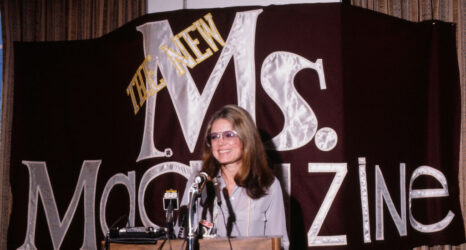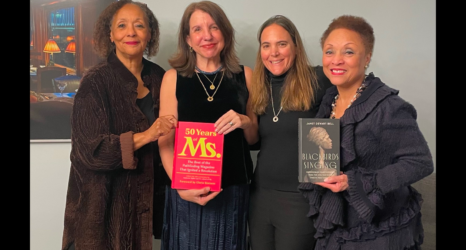Laurie Halse Anderson is the award-winning writer of groundbreaking young adult, children’s, and historical fiction books such as Speak, SHOUT and The Seeds of America Trilogy.

For her most recent book, the New York Times bestselling author teamed up with DC Comics and an amazing group of women artists on a graphic novel telling the story of Diana of Themyscira as a teen—before becoming the iconic Wonder Woman.
Ms. spoke with Laurie Halse Anderson about the process of writing her latest book, the work of white feminism, and how she maintains creativity during COVID.
Karla J. Strand: In your new graphic novel, Wonder Woman: Tempest Tossed, you share your story of Diana before she becomes Wonder Woman. So, what is sixteen-year-old Diana like?
Laurie Halse Anderson: She’s like 16-year-olds everywhere—except that she grew up on Themyscira.
She was the first baby on Themyscira because the Amazons were all created as adults from the goddesses in one moment. She was the first baby they ever saw. So in addition to not really having any peers, she’s hitting her adolescence in a place unlike any other.
For me, her truest, most powerful strength is her need for justice. She’s got a really clear compass heading that points towards justice and fairness for everybody. We see that in her confrontation with her mother that winds up with disastrous consequences for her. And we see that once she begins to evaluate what’s going on at the refugee camp and in the United States of America.
You know, [Diana is] a very compassionate, loving person. I did not want her to have any romantic interest because she is still learning how to fall in love with herself. And then she has to learn the art of friendship. That was why I made the choice of not having Steve Trevor be somebody that she loses her heart to. We still have Steve Trevor, but it’s Steve and Trevor in my book.
I think Diana offers us a lens to look at the terrible inequities and injustices in our world and remember what we all felt like when we were growing up, when we were beginning to learn about these things. I think one of the debilitations of being an adult is you kind of settle. The power that teenagers bring to us—which is why revolutions are always led by the young—is they have the energy, but also they’re not gonna put up with the status quo if they think it’s wrong. That’s something that we all need to remember and respect them for. And so to be able to see the horror on [Diana’s] face—and can we shout-out Leila del Duca, the artist of this book?!—but that moment that Diana understands the ramifications of child trafficking, you can just see it. It just punches her in the gut; it eviscerates her. It should eviscerate everyone in every moment!
And she’s also not gonna put up with street harassment, no! She’s fighting. She reminded me what real strength is.
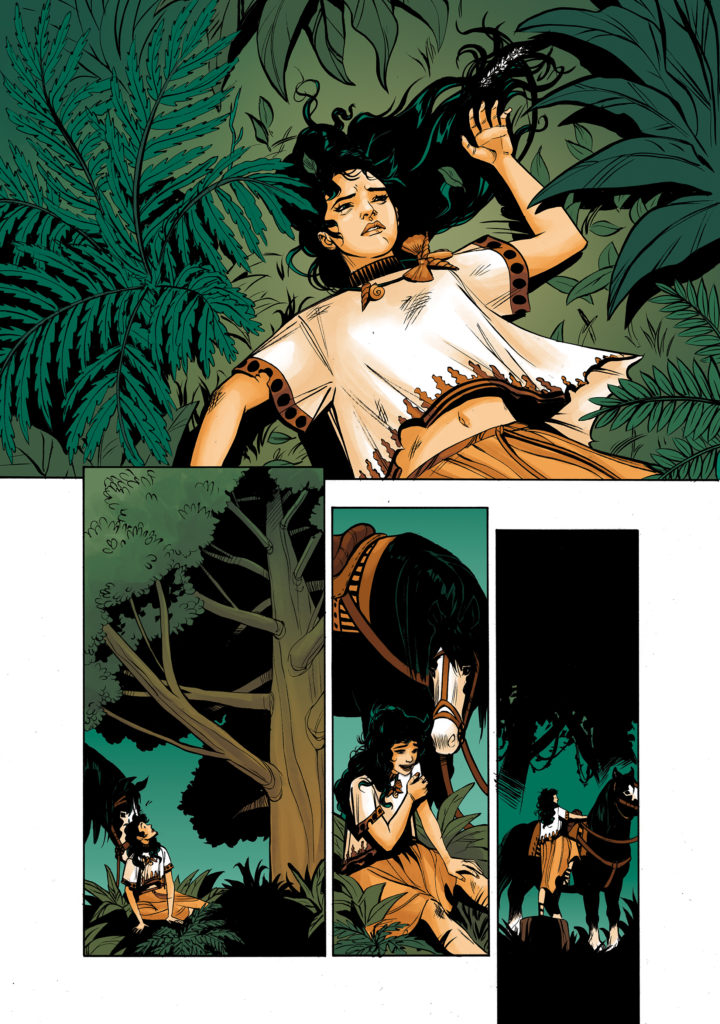
KJS: And how much freedom did you have to interpret that Diana story?
LHA: Working with DC Comics was amazing. It was really fun. They gave me some guidelines that were simple: She has to be 16; they wanted the story to begin on Themyscira, which I loved. Then, I had to bring her to New York. They said, don’t worry about any continuity issues because Wonder Woman’s the iconic figure and [she’s] been around in so many iterations and storylines. So, thank goodness, I didn’t have to worry about that.
But I was always very mindful; I feel so honored by the chance to contribute my book to the work of other artists and writers stretching back generations. And it was super fun! I mean, creatively, one of my favorite projects.
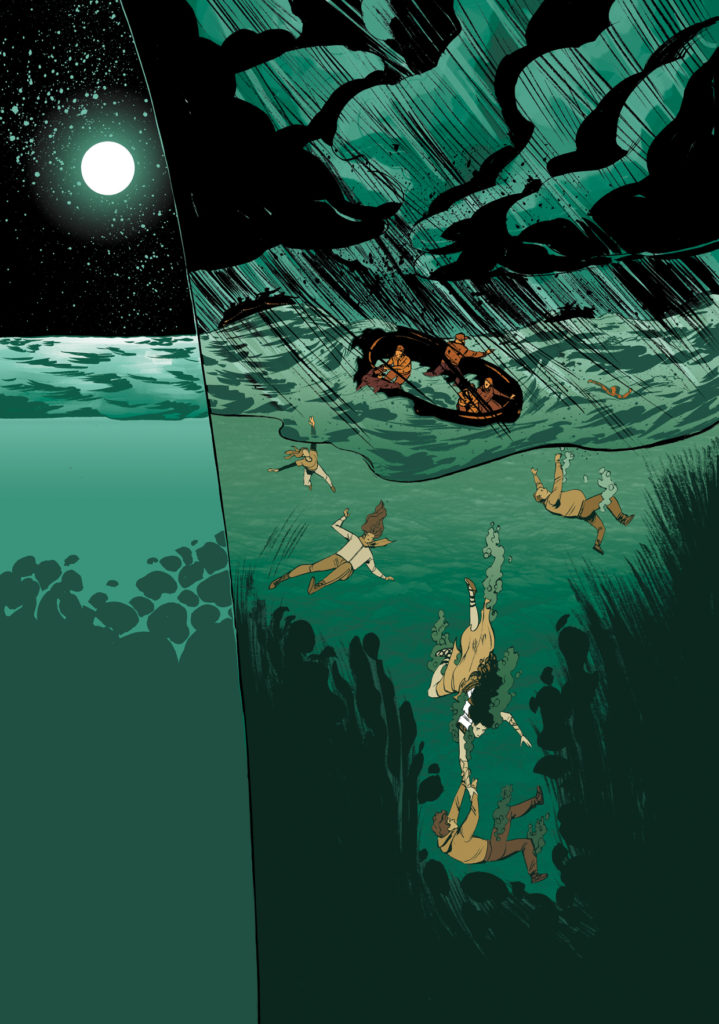
KJS: How did it feel to take on such an iconic character? I mean, how do you even start that process?
LHA: Well, we have to go back to 1972, which was a pivotal year for me—and Ms. Magazine. That was the year that I began to open my own eyes, began to leave childhood behind. I had a mother whose image of what a woman can and should be was very different from mine. And 1972 was a powerful year to be coming of age as a girl.
Wonder Woman gave me the model that I felt more comfortable with, gave me a model of a woman who could be a woman and be strong. She could use her intelligence and her heart and her muscles and all those special powers that we all have even if we don’t have her bracelets. So instead of being intimidated, I felt like I got to go and hang out with somebody who’s been a friend of mine for almost my entire life.
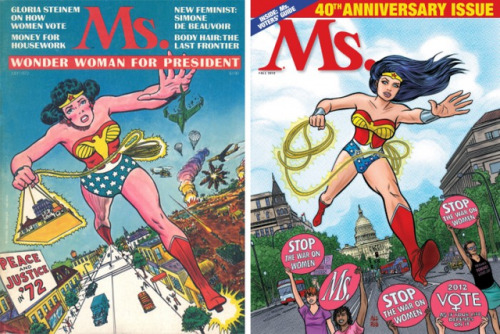
KJS: And you mentioned 1972, the year of the first Ms. Magazine [and the first Wonder Woman cover]. And she’s graced the cover of Ms., what, five times now? And Gloria Steinem has talked about the importance of Wonder Woman. Why do you think it’s important to continue introducing Wonder Woman to new generations?
LHA: Well, because we’re still dealing with the patriarchy for one thing. You know, we’ve made progress, but we’re still not being paid equally. Women don’t have equal access to reproductive rights all over the country. There are so many battles to fight.
And I think that white feminism still has some work to do—or a lot of work to do—in terms of intersectionality, in terms of honoring the different—and in most cases harder—struggles of our sisters of color and of our transgender sisters. So, we have a lot of learning and growing to do. And every movement needs heroes. Gloria Steinem is one of mine, for the record, and I feel one circle closer to Gloria Steinem because we both love Wonder Woman so much!
This is also where story is critically important. And think about what a horrifying year we’re trying to get through right now in 2020! More than ever, we need stories that will invite conversations, stories that will help build and strengthen community and give us comfort in these dark times.
KJS: Yes, and I think the graphic novel format is such an interesting genre to be able to do that. Can you talk a bit about the genre? Why was it important for you to write about Wonder Woman in a graphic novel format?
LHA: I wrote the adaptation for the Speak graphic novel and that came out in 2018, so that was a great introduction to the form. I had written picture books but graphic novels are way more complex.
I actually believe that graphic novels are way better at helping readers understand and develop empathy for characters than text-based novels. The graphic novel brings another layer of literacy to the storytelling component. [They] are every bit as complex and valid a reading choice as text-based novels.
I think anybody under the age of 40 has to navigate visual literacy spaces constantly. It’s important that they have these opportunities to learn how to look for information on a page and understand how the story is told not only through the image and the text but also through the colors, through the panel choices. The creative part of me had so much fun balancing the page turns in the graphic novel. Because every time somebody turns a page, there’s a moment of tension. How is this scene going to be continued? So that was super fun.
With DC [Comics], there was so much cooperation and fluidity. And everyone who worked on this book was female: Leila del Duca was the artist, Kelly Fitzpatrick was the colorist and Saida Temofonte was the letterer. So it was kind of this Amazonian group of women who tried to honor our hero with her story.
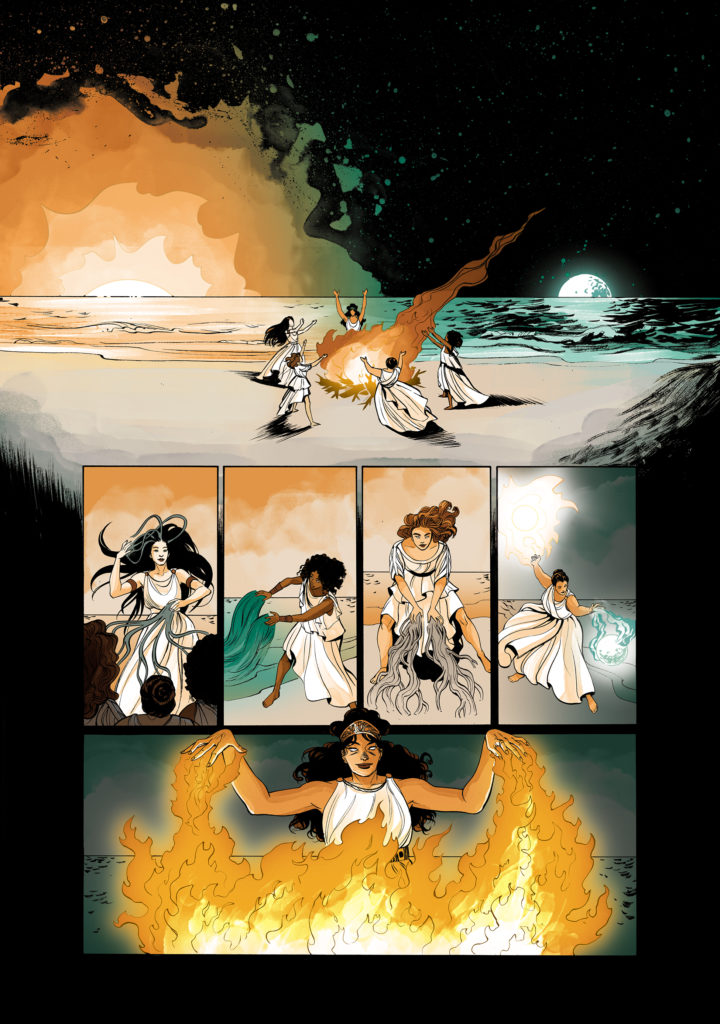
KJS: So, it doesn’t sound like one process or another is more or less creative, it’s maybe differently creative.
LHA: Right. And once we get through the summer, I have another novel to write and I seriously believe that this experience is going to change the way that I write novels. I think I just became a more visual writer.
KJS: As we are talking about creativity, and you’re getting ready to write a new novel, I wonder how you’ve been able to stay creative and motivated during the pandemic.
LHA: I was sick in March with what may have been COVID or the flu. [It wasn’t diagnosed] but I lost about six weeks of my life. Fever of 103 … it was not fun. But thankfully I didn’t have to be hospitalized, I was able to just hole up at home.
When I was just recovering and finally up and moving, I couldn’t go very far at first, but first thing in the morning, I would get up and go outside and walk. For me, that has become such an important part of my emotional health: getting outside, seeing trees, avoiding people, wearing a mask, playing by the rules. It sounds so simple but it’s essential for me: being outside every day a little bit—and now I can walk longer and longer.
But in terms of the creativity, when I’m walking, that’s when things bubble up from inside me. That’s when the ideas percolate. If I’m in the house, I tend to be feeling anxious, I tend to be checking my phone for the news, and I can think about all the bad things. But one of the good things that can come out of a very dark time is that it helps clarify what you care about and when you can align yourself with your deepest priorities, then you can do the work that you were put on the Earth to do.
KJS: So, what can you tell us about the new novel you’ll be writing soon?
LHA: You know, I’m really struggling. I write out of anger—anger is such a great tool for artists—I really write about what pisses me off. I’m spending a lot of time trying to really deeply understand the privileges that I grew up with as a white woman. You know, I’m cisgender, I’m heterosexual, middle-class, Protestant Christian. It’s been like a 20-, 25-year journey for me, and that’s one of the things that I might be exploring. But of course, the trick is to figure out how to tell a story that is true to your heart but without being didactic. That’s why I have a lot more long walks ahead of me, but I trust the process.
Tempest Tossed is really a story about the American Dream. And the American Dream is amazing, and we wrote ourselves some promises about that dream, right? We wrote the Declaration of Independence and the Constitution and at the foot of the Statue of Liberty is the best articulation ever: give me your tired, your poor. But those are promises we have not yet fulfilled for all of our people. Diana is such a great symbol of the work we have to do, especially those of us who were, by the luck of the draw, born into privilege and advantage. I love the goal we’ve set for ourselves as Americans, and I want to help us all reach that goal.
KJS: I think the book does a wonderful job in addressing those themes. I can see that and other threads of Diana’s life and of her story that could continue…
LHA: [Laughing]
KJS: I’m sure that readers want to know: Will there be more Wonder Woman graphic novels in your future?
LHA: Well… so the next project is actually underway right now. It’s a little bit different than this one though. On the next project, I’m an editor. I’m doing a graphic novel version of an anthology called Wonder Women of History. I’m working with a group of writers and artists to highlight the badass women of our world and the incredible contributions that they’ve made in all fields. That should be published in December.
And then in terms of doing another fictional story about our princess? Stay tuned.
Wonder Woman: Tempest Tossed is out now from DC Comics.
You can find Laurie Halse Anderson online at https://madwomanintheforest.com/.
Follow her on Twitter and Instagram @halseanderson.




